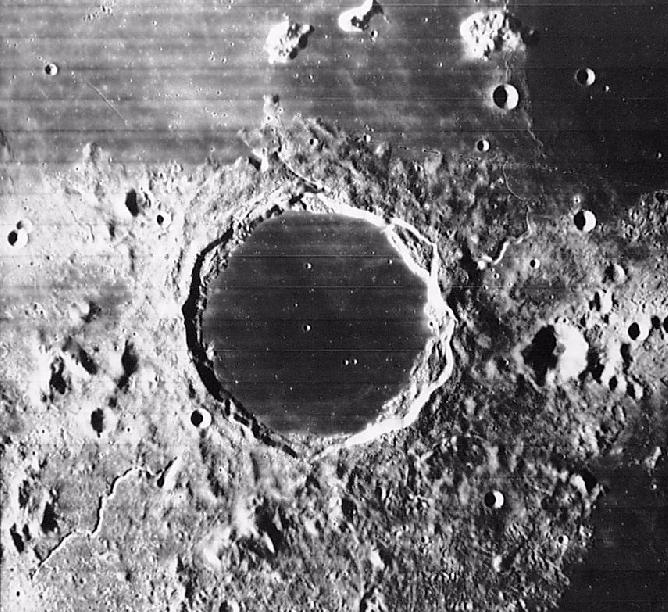Observing the Moon: Plato Revisited
Jack Kramer
Plato is one of the more prominent craters on the Moon, plus it lies in an area with many interesting features. There was an article on Plato in the February 1999 NightTimes, but as with many lunar features, Plato is worth a revisit, especially after seeing the minute features revealed in the Lunar Orbiter images. The following image of Plato from the Lunar Orbiter spacecraft is oriented as it would appear in a reflecting telescope, with south up.

Although the floor of Plato at first appears flat, smooth and featureless, notice in the above image that there are several small craters there. These craterlets are a good test of a telescope's optics. Schmidt's Charte der Gebirge der Mond (Chart of the Mountains of the Moon) from 1878 is apparently the first map to show craters on Plato's floor. These are the sort of challenging objects viewed only on nights when the seeing is especially good. I had always figured that in order to catch them, the sun would have to be at a low angle in order to maximize the shadows. So it came as a revelation as I observed with the 4-inch refractor during an almost-full moon and saw the floor of Plato with three craterlets just visible as bright spots. (The two little adjoining craters appeared as a single point of light.) Here they were with a fairly high sun shining on the lunar surface. At the time, I was using a 5mm Orthoscopic eyepiece, giving 196x. That prompted me to do a little research to determine when the craterlets would become visible in a modest telescope. Starting the following month with an 8.8 day-old moon (just past first quarter) and Plato at the terminator with nice long shadows, there was no sign of the craterlets, either in the 4-inch refractor or in a borrowed 6-inch Newtonian. There was no sign of the craterlets subsequently with a 9.7-day old moon. Finally, with a 12.4-day-old gibbous moon, the craterlet in the dead center of Plato became visible directly in the 4-inch in moments of good seeing, and the others were just fleetingly glimpsed. I continued this experiment over the next several months. Three craterlets became easier targets on a 13-day old moon, with a fourth just barely visible. A 14.2 day moon did not offer any better view. On a 17-day-old waning gibbous moon, the craterlets were fairly easy to see. One observer reported that on a night of virtually perfect seeing, with a 4-inch apochromat he was able to see seven craterlets in Plato. Using my 6-inch apochromat, all the larger craterlets were easily seen as bright spots on a 13-day-old moon. I also found that a binocular viewer on the scope helps a great deal because the craterlets seem to stand out more prominently.
This proves that the craterlets do not need deep shadows to be seen, but as reflection features they are easier when the sun is high in the lunar sky. Because they appear as little pinpoints of light under this condition, they must act almost like parabolic reflectors. However, in larger telescopes with good resolution, the craterlets show up when nearer to the terminator and do have an internal shadow from their low walls. The size and optical quality of the telescope are important, but the Earth's atmosphere (seeing condition) has the last word. Never assume what can or cannot be seen!
The image here shows many other fine details on the floor of Plato, as well as in the surrounding area. Parts of the long rill on the northeast side of Plato (to the lower left in the image) were just visible in the 4-inch under high magnification. With a low angle of illumination, the rugged area just to the southwest of Plato (to its upper right in the image) appears darker, presumably due to many long shadows and the low reflectivity (albedo) of the regolith. With a high angle of illumination, such as on a gibbous moon, the shadings on the floor of Plato show up well, especially a large V-shaped lighter area.
Note that in the Orbiter image here, Plato is almost perfectly circular. But from Earth, Plato appears more oval due to the foreshortened perspective of its fairly high northerly latitude on the moon.





